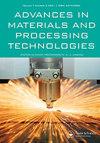Analysis of CNC turning parameters and simultaneous optimisation of surface roughness and material removal rate by MOGA for AISI 4340 alloy steel
IF 2.1
Q3 MATERIALS SCIENCE, MULTIDISCIPLINARY
Advances in Materials and Processing Technologies
Pub Date : 2023-11-12
DOI:10.1080/2374068x.2023.2280293
引用次数: 0
Abstract
ABSTRACTThis article has made an approach towards the multipass turning of AISI 4340 alloy steel with minimum quantity of coolant to determine the Optimal Turning Parameters for simultaneous maximisation of material removal rate and minimisation of surface roughness. Nine experimental runs were planned according to Taguchi’s Design of Experiments and performed on Computer Numerically Controlled Lathe Machine with high carbon steel as a tool. The mathematical models developed for surface roughness and material removal rate at different levels of speed, DOC & feed rate are considered as objective functions. Less than 5% error was observed when experimental results were compared with Regression and ANN Models for both responses. A multi-objective genetic algorithm and a Grey relational analysis were used to determine the optimal turning parameters and the results were validated experimentally. The MOGA provides the best optimal parameters for the simultaneous achievement of SR minimisation and MRR maximisation. Results reveal that speed and feed rate have a significant effect on responses. The Pareto Front Plots extracted from MOGA provide the minimum Ra value, 2.32 µm and for the same point, maximum MRR is 6894.22 mm3/min. However, the experimental method could not meet this Ra value, but the recorded minimum was 2.67 µm and the MRR was 6544.79 mm3/min.KEYWORDS: AISI 4340 alloy steelCNC multipass turningsurface roughnessmaterial removal rateGRAMOGAANNregression Nomenclature SR (Ra)=Surface Roughness in µmMRR=Material Removal Rate in mm3/minS (SS)=Speed in rpmDOC=Depth of Cut in mmFR=Feed Rate mm/revMOGA=Multi Objective Genetic AlgorithmGRA=Grey Relational AnalysisGRG=Grey Relation GradeANN=Artificial Neural networkMQC=Minimum quantity of coolantOF=Objective functionCNC=Computer Numerical ControlOA=Orthogonal Arrayw/p=Work pieceDisclosure statementNo potential conflict of interest was reported by the author(s).Data availability of statementThe data was collected from original research work and optimisation of data is done with a genetic algorithm and GRA process.Code availabilityThe datasets generated during and/or analysed during the current study are available from the corresponding author upon reasonable request.AISI 4340合金钢数控车削参数分析及表面粗糙度和材料去除率的MOGA同步优化
摘要本文对AISI 4340合金钢在最小冷却剂用量下的多道次车削进行了探讨,以确定同时实现材料去除率最大化和表面粗糙度最小化的最佳车削参数。根据田口的《实验设计》,在以高碳钢为工具的计算机数控车床上进行了9次实验。以不同速度、DOC和进给量下的表面粗糙度和材料去除率的数学模型为目标函数。将实验结果与回归模型和人工神经网络模型进行比较,误差小于5%。采用多目标遗传算法和灰色关联分析方法确定最优车削参数,并对结果进行了实验验证。MOGA为同时实现SR最小化和MRR最大化提供了最优参数。结果表明,速度和进给量对响应有显著影响。从MOGA提取的Pareto Front Plots提供了最小Ra值2.32µm,对于同一点,最大MRR为6894.22 mm3/min。然而,实验方法不能满足该Ra值,但记录的最小值为2.67µm, MRR为6544.79 mm3/min。关键词:AISI 4340合金钢数控多道次车削表面粗糙度材料去除率gramogaannregression命名法SR (Ra)=表面粗糙度以µmMRR=材料去除率以mm3/min (SS)=速度以rpmDOC=切割深度以mmFR=进料速度mm/revMOGA=多目标遗传算法mgra =灰色关联分析grg =灰色关联等级ann =人工神经网络mqc =最小冷却量of =目标函数cnc =计算机数控loa =正交阵列w/p=工件作者报告了潜在的利益冲突。数据的可用性数据来源于原始研究工作,并通过遗传算法和GRA过程对数据进行优化。代码可用性在当前研究期间生成和/或分析的数据集可根据合理要求从通讯作者处获得。
本文章由计算机程序翻译,如有差异,请以英文原文为准。
求助全文
约1分钟内获得全文
求助全文
来源期刊

Advances in Materials and Processing Technologies
MATERIALS SCIENCE, MULTIDISCIPLINARY-
CiteScore
3.90
自引率
27.30%
发文量
222
 求助内容:
求助内容: 应助结果提醒方式:
应助结果提醒方式:


